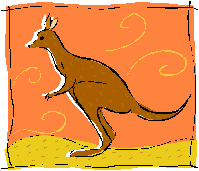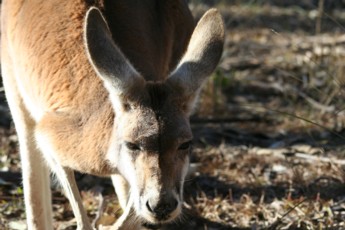CLASSIFICATION AND PHYLOGENY
![]()
Domain: Eukarya
Kingdom: Animalia
Phylum: Chordata
Class: Mammalia
Order: Diprotodontia
Family: Macropodidae
Genus: Macropus
Species: Macropus rufus
The Red Kangaroo has been classified at each taxonomic level for specific reasons. This species is Eukaryotic because its cells contain a membrane bound nucleus. It is in the Kingdom Animalia because it is reactive to environmental stimuli, eats other organisms for energy, and is multicellular. It is in the Phylum Chordata because this species has pharyngeal slits, a dorsal nerve cord, a notochord, and a post-anal tail. It is in the Class Mammalia because it is able to produce milk through mammary glands, it has hair, and has three inner ear bones. It is in the Order Diprotodontia because this species has fused hind feet digits, unfused claws, three pairs of incisors in the upper jaw, one pair on the lower jaw and its canines are present on the lower jaw but absent from the upper jaw. The Red Kangaroos is in the Family Macropodidae because it has a specialized digestive system that help break down grasses, four pairs of molars, a pouch, and a long tail and large feet that help aid in movement. It is in the Genus Macropus because this genus includes both kangaroos and wallabies. It has the species name Macropus rufus because of it's distinctive has reddish-brown fur and facial features.
Phylogenetic Tree

(I constructed this phylogenetic tree using information from a variety of sources. Some parts of the tree may be misrepresentative since the page provides limited space. Also I was unable to attain information as to if certain groups are monophyletic or polyphyletic. In the following explanation of the tree I will be sure to clarify which parts of the tree may be misleading.)
The complete evolutionary history of the Red Kangaroo is still somewhat unknown. It is believed that ancestors of kangaroos were small, possum-like marsupials that lived in trees about 50 million years ago. Researchers state that when these marsupials began living on land instead of trees, they began developing the skills to hop. About 25 million years later four families developed,including the hypsiprymnodontines, the potoroines, the balungamayines, and the propleopines. The propleopine family has since gone extinct while the potoroines today are known as potoroos and bettongs. Kangaroos are believed to have come from the macropodinae family that eventually differentiated into 11 genera including the tree kangaroos (Dendrolagus), the dorcopsis' (Dorcopsis), the dorcopsis' (Dorcopsulus), the hare-wallabies (Lagorchestes), the banded hare-wallabie (Lagostrophus), the nail-tailed wallabies (Onychogalea), the rock wallabies (Petrogale), the quokka (Setonix), the pademelon (Thylogale), the swamp wallabies (Wallabia), and finally the kangaroos, wallaroos, and wallabies (Macropus). Although the phylogenetic tree above represents the split of the genera as monophyletic, I was unable to find information as to when and how these groups split apart, and therefore the tree is not completely accurate.
From the genus Macropus, sixteen species arose. The Agile Wallaby (M. agilis), M. albus, Antelopine Wallaroo (M. antilopinus), Black Wallaroo (M. bernardus), Black-Striped Wallaby (M. dorsalis), M. elegans, Tammar Wallaby (M. eugenii), Western Gray Kangaroo (M. fuliginosus), Eastern Grey Kangaroo (M. giganteus), Toolochi Wallaby which is extinct (M. greyi), Black-Gloved Wallaby (M. irma), Parma Wallaby (M. parma), Whiptale Wallaby (M. parryi), Wallaroo (M. robustus), Red-Necked Wallaby (M. rufogriseus), and the Red Kangaroo (M. rufus). I was unable to find the complete phylogeny of when and how these species differentiated. Therefore, the diversion of species represented on the phylogenetic tree is not completely accurate. However, it is accepted that the Red Kangaroo is the most recently evolved species in the genus Macropus because of its adaptations and ability to live in very dry habitats.


